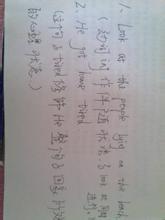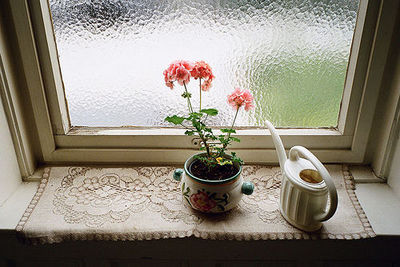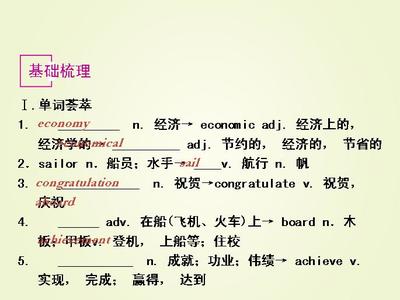形容词在句中作定语、表语和宾语补足语的情况很多,但作状语的时候也不少。如:Thebagfellonthefloorandbrokeopen.袋子掉到地上摔破了。Gladtoaccept,thegirlnoddedheragreement.这姑娘乐于接受,点头表示同意。
形容词(短语)作状语时,通常说明主语的情况,即表示主语的状态、性质、特征等,有时它和宾语的关系密切,且可位于句首、句末和句子中间,通常和句子的其它部分用逗号分开,但单个形容词可以连在一起。
一、形容词(短语)作状语说明主语的情况,可以表示动作或状态发生的原因、方式、时间等,或对谓语作补充说明。
1.表示原因,但原因意义不很突出,有时是并列的。例如:
Afraidofdifficulty,hepreferstodotheeasymathsproblem.他害怕困难,宁愿做容易的数学题。
Anxiousforaquickdecision,ourleadercalledforavote.我们队长急于迅速作出决定,要求进行表决。
2.表示方式。例如:
Thelostboyspentthreedaysintheforestcoldandhungry.那个迷路的男孩又冷又饿地在森林中过了三天。
Themoonhadjustrisen,verygolden,overthehill.月亮刚刚升起,挂在山上,十足的金黄色。
3.形容词(短语)作状语时,它和句中谓语动词在意义上的联系不密切,只是对谓语补充说明。
EffectivethefirstofOctober,oursupermarketwillcloseateleven.我们超市十一点关门,从十月一日起生效。
Contrarytoalladvice,theystartedtoclimbthemountainduringastorm.他们不听一切劝告,冒着风暴出发登山。

4.形容词(短语)作状语可表示时间。例如:
Ripe,thesepeachesaresweet.这些桃子熟了时是很甜的。
Enthusiastic,theymakegoodstudents.用功的时候,他们是好学生。
二、说明宾语的情况时,形容词(短语)作状语紧接其后。例如:
Theyatethebeefcold.他们吃的牛肉是凉的。
Ipushedthewindowopen.我把窗子推开。
这种结构为被动句时,形容词则又变为说明被动句中主语的情况。例如:
Thedoorwaspushedopen.门被推开了。
Theappleswerepickedripe.这些苹果是熟的时候摘的。
一、形容词或形容词短语作状语,表示方式或伴随,说明谓语动作的方式,它在句子中有时像非限制性分句一样,表示意义上的增补。其逻辑主语是句子的主语。在这种情况下,其位置比较灵活,可位于句首或句末,有时也可位于句中。
Crusoe stared at the footprint, full of fear.(= Crusoe, whowas full of fear, stared at the footprint.)克鲁索两眼盯着脚印看,满心恐惧。
Flushed and breathless, she bounded in through the gate.她满脸通红气喘吁吁从大门口跑了进来。
二、形容词或形容词短语可以作原因状语,一般位于句首,有时也可位于句子中间。
Afraid of being scolded, for a moment, little Franz thought ofplaying truant.(=As he was afraid of be ing scolded, for a moment,little Franz thought of playing truant.)由于害怕挨骂,小弗朗兹一时起了逃学的念头。
Eager to improve farming conditions, they tried out this newcrop on a large area.(=As they were eager to improve farmingconditions, they tried out the new crop on a large area.)由于急于改进耕作条件,就大面积地试种了这种新庄稼。
Tom, very ill, sent for a doctor.(=As Tom was very ill, hesent for a doctor.) 因为汤姆病得很厉害,派人请医生去了。
三、形容词或形容词短语可以作状语,表示时间和条件。通常位于句首,也可位于句末。
Ripe, these apples are sweet.(=When/If these apples are ripe,they are sweet.) 熟了的时候这种苹果很甜。
Enthusiastic, they are quite cooperative.(=When/If they areenthusiastic, they are cooperative. ) 热心的时候他们是很合作的。
四、形容词或形容词短语可以作让步状语,常由一个形容词或连词or连接的两个或两个以上的并列形容词构成。一般位于句首,有时也可位于句中。
Right or wrong, he always comes off worst in an argumentbecause of his inability to speak coherently.(=Whether he is rightor wrong, he always comes off worst because of his inability tospeak coherently.) 无论有理还是无理,由于他语言条理欠佳总是把事情弄得最糟。
Wet or fine, he got up at six and took a walk in thepark.(=Whether it was wet or fine, he got up at six and took a walkin the park.) 不管天晴还是下雨他总是六点起床在公园里散散步。
The two accidents, tragic, seemed natural enough. (=Thoughthey were tragic, the two accidents seemed natural enough.)尽管两场事故损失惨重,然而是必然的。
五、形容词或形容词短语可以作状语,表示结果和状态等意义。它在句中的位置比较灵活。
For a moment she just stood there, unable to believe what hadjust happened. 她在那儿呆呆地站了一会儿,不敢相信刚才发生的事情。
One woman was lying in bed, awake, listening to the rushingwinds. 有一位女人醒着躺在床上,静听着那疾驰而过的大风。
They stayed in the snow for several days, cold and hungry.他们在雪地里呆了几天,又冷又饿。
六、形容词或形容词短语可以作状语, 表示说话人的态度和看法。它通常位于句首。
Worse still, the lion could even carry off the baby in itsmouth.更糟糕的是,狮子甚至可能把婴儿叼走。
Surprising, there are five SARS patients in his family.真惊人,他一家就有五位“非典”病人。
Necessary, young people can speak good English.年轻人会说通顺的英语是必要的。
 爱华网
爱华网


